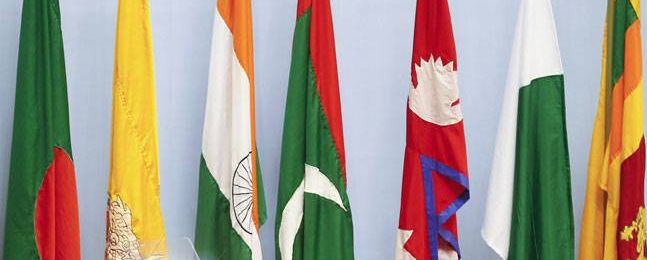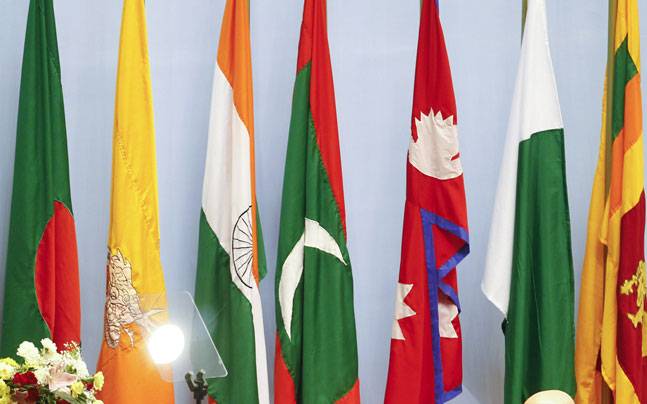The states have political necessities that may not concur with the conscience of their people – a disconnect reflected in the constitutive character of the SAARC.
Four member states recently withdrew from the SAARC summit that was to be held in Islamabad, affectively scuttling the meeting. This has raised several questions – from the continued existence and overall usefulness of the regional grouping, to the foundational concern of how to work out issues of regional cooperation. As a process, the dominant understandings of regional cooperation have been mostly looked at from the perspectives that privilege space, in the geophysical and cartographic sense, as opposed to the less tangible possibilities of culture and collective imaginings of the past. In this context, the idea of cooperation has focused on relationships based on territorial identities, marked by militarised borders and geophysical spaces surrounded by these borders, which have come to typify the general and popular conceptions of what is meant by nation states.
This has allowed politics and economics of nation states to become the most significant dimension of the hegemonic discourses of regional cooperation. In this process, it loses track of the actual sites inhabited by people, which are the messy cultural and emotional spaces beyond these territorial boundaries. This has become evident in the way states have to work through their own formal bureaucratic mechanisms, while the initiatives of the people, and the imagination of scholars and creative people of the region, have often been very different and more inclusive than that of the state.
In general, these non-hegemonic approaches have not been recognised at the level of formal statecraft. The obvious disconnect between the people and the nation is reflected in the constitutive character of the SAARC.
In these general circumstances, it is important to see the disconnect between the people and the nation in context of regional politics. It is the ‘nation’ (the bureaucracies, ministries and political players with power) that interacts with the others, and the idea of regional cooperation is framed through the idioms in which they converse and in the initiatives they plan.
Most of these interactions – be they bilateral linkages or multilateral forums like SAARC – clearly indicate the inability of nation states in the region to transgress their rigid boundaries dictated by notions of sovereignty.
They do not debate the format of conversations that could take place among the different constituencies of South Asia, which would allow cooperation to become a less strenuous reality. That necessitates a certain self-conscious dilution of the rigidity in the identities of nation states for the greater good of the collective.
It was in such a situation that an entity like the European Union became a reality despite its many fallacies. States have their own structured internal and external political necessities, which may not concur with certain manifestations of the collective consciousness of the masses that inhabit these countries.
The Sri Lankan Buddhist pilgrims who annually flock to Buddhist sites all over India, hardly interact with India, the nation state, except at points of entry and exist, and a few places in between, due to a mundane necessity, which is often negotiated by ‘experts.’ Instead, they travel through a mythic and historic landscape that they see as Dambadiva and not really India.
Similarly, the Hindu travellers who go to Sri Lanka to visit sites believed to have been associated with the story of Rama and Sita in the Ramayana, hardly experience Sri Lanka, the post-colonial nation state. Instead, they embed themselves in an ancient land of multiple meanings. But these kinds of possibilities that are offered by culture and recollections of the ancient past hardly form any serious bases for regional cooperation today.
Hence, in situations of this kind where broad-based conversations have been absent, and where it is all too common to assume a few terrorists as representatives of entire nations, crises and distrust between nations can easily become a hallmark of interstate interactions.
Unfortunately, such possibilities also have popular currency in difficult times. This mistake persists because the simplistic instrumentalism of state-led cooperation does not give priority to the popular – their sense of belonging or their actual life situations.
Rather, in a Debordian sense, “everything that was directly lived, has receded into a representation,” and the states seem to have worked hard to establish what Guy Debord called a “pseudo-world” through presenting life as a spectacle, which “is a concrete inversion of life, an autonomous movement of the non living”.
Diplomatic moves, regular foreign relation measures, or the possible militarisation of some of these activities, are those spectacles, which so succinctly transform actual human relations into unreal spectacles and performances of power with considerable popular appeal. Within this collective of spectacles and performances, the idea and possibilities of any real regional cooperation often get trapped and dismantled.
The consequences of this instrumentalisation of everyday life indicate the loss of a great history, the diminishing of a massive possibility and an important derailing of a collective counter-culture of solidarity. Irrespective of contemporary political spin, the reality of the region is not the persistence of violence, conflict and nationalist frenzy, it is the negatively spectacular manifestation of it, the unreal that has become the overwhelming reality.
Under such circumstances, one often wonders if the connection between these nations can be forged through an instrumentalist mechanism alone that tries to build formalised, ritualistic bridges. One will have to invoke the spirit of Nazrul Islam who was writing ‘Shyama Sangeet,’ songs in praise of Kali, and for the proletariat of the region as well when he composed ‘Sarbahara’. He would die a man extremely angry and aghast at the violence and religious sectarianism devouring the region. Any culturally sensible regional cooperation would have to bring into conversation Faiz Ahmed Faiz, who would stir the masses across borders through his poetry of love and revolution. It is in his spirit of discomfort at the larger socio economic milieu of oppression and deprivation that he would compose in intessab (dedication) or would express in angst in conversation with his beloved in ‘Mujh se pehli si muhabbat mere mehboob na maang’ (‘Oh my love don’t ask me for the love I once gave you’).
The cooperation between people across borders will have to speak in a language that Sahir Ludhianvi was making use of when he condemned war in his beautiful ‘Parchhaiyan’. Resurrecting more sensible older conversations and creating new avenues of expression in the arts, poetry other expressions of popular feelings, will have to constitute a more historically and culturally rooted sense of regional consciousness.
This would need to counter the often hollow and flippant mantra like the articulation of ‘regional consciousness’ and ‘South Asian sensibility’ that we often hear from forums of nation states as well as from SAARC. These are mere utterances without feeling or deeper meaning. Any consciousness, if imposed as mere political slogan, would cease to be a consciousness except in sense of being unreal, being hyper-real or simply nonsensical.
SAARC has created institutions, which can – in an ideal world – become effective in initiating the processes of forging a more organic and critical understanding of the idea of regional cooperation. In theory, the SAARC Cultural Centre in Colombo is one and the South Asian University in New Delhi is another. Both, again in theory, have significant possibilities to initiate conversation across borders between intellectuals, cultural producers, civil society groups and the citizens in their formative years (the students). In fact, this is what South Asian University’s motto ‘Knowledge Across Borders’ boldly proclaims.
But this would be possible only if these institutions can first unlearn how to think like nation states while recreating rituals of statecraft. So despite its potential, SAARC Cultural Centre works like an amalgamation of state bureaucracies, which thereby stifles the outcome of its potentially important work. In comparison, the South Asian University, in its knowledge production and student induction programs, works independently and offers far better results, though by no means perfect.
Nations consisting of people in flesh and blood would forge a better understanding among themselves only when there is an organic process of interaction binding them. But today, by and large, nations in our region have forgotten their own people. They get subsumed within the nation and become faceless, nameless statistics. They lose their voice and their ability to converse.
There is an immediate need to begin conversations as militarisation and nation-centric politics will not work through these moments of anger and angst, particularly if regional cooperation is the preeminent ideal. We need to imagine South Asia differently in a new framework with a sense of hope. As Ernst Bloch has noted, “hope means venturing beyond”.
But moving ‘beyond’ and looking for ‘hope’ is not something that the nation states in our region or SAARC could possibly do. It is an endeavour that lies beyond these rigid and unimaginative structures. It was in such a context that Ashis Nandy once said, “the more the scholars, artists and writers talk of the common heritage of the region, the more the functionaries in the region nervously eye their neighbours as enemies planning to wipe out their distinctive identities.”
It is precisely this sense of embedded subversiveness in the acts of reaonable people that would be needed to redicover South Asia.
Ravi Kumar is an Associate Professor of Sociology and the former Chairman of the Department of Sociology at South Asian University, New Delhi. Sasanka Perera is a Professor of Sociology and the Vice President of South Asian University,

